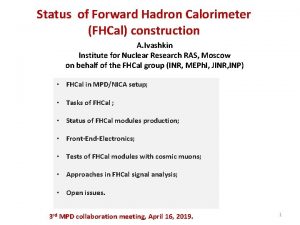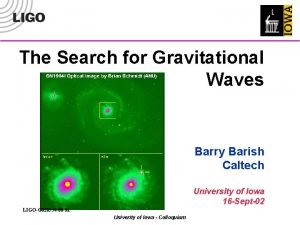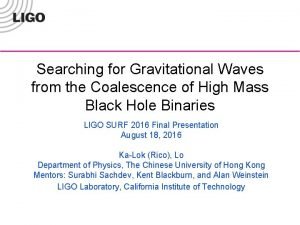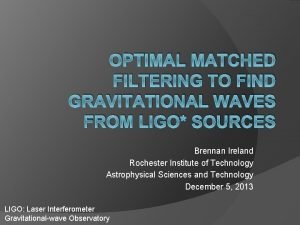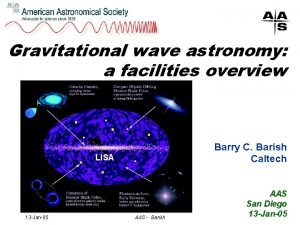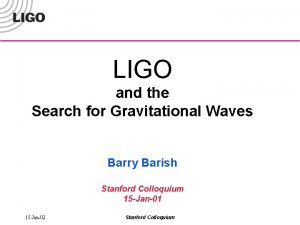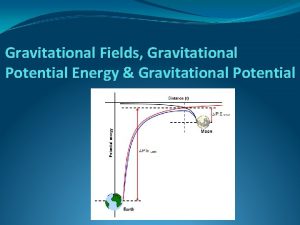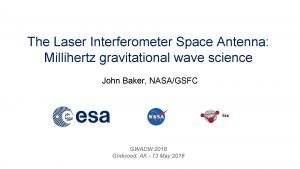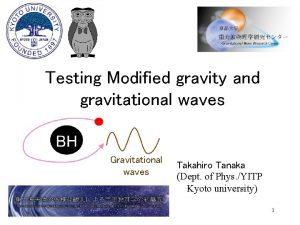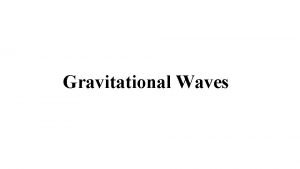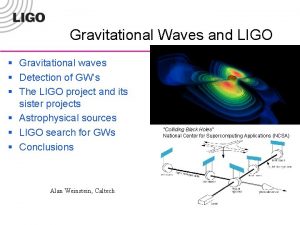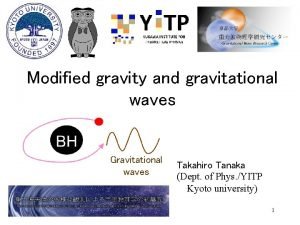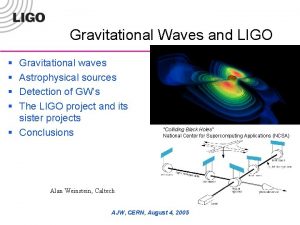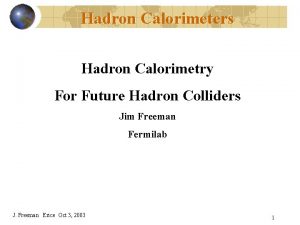Detecting millihertz gravitational waves using the Large Hadron
















- Slides: 16

Detecting millihertz gravitational waves using the Large Hadron Collider Hamburg Observatory researchers involved: Suvrat Rao (QU Ph. D student), Prof. Dr. Marcus Brueggen, Prof. Dr. Jochen Liske

Ø In talks with the LHC beam operation group at CERN regarding their project ‘Physics beyond colliders’

Outline of the experiment concept

GW polarizations, orientation

Laser interferometry detection principle

Sensitivity curves of GW detectors Major noise sources in laser interferometry: 1. Gravity gradient (GG) noise at low frequencies. 2. Thermal noise at high frequencies. Laser path length determines GW frequency range to which the detector is sensitive.

Effect of GWs on proton bunch test masses (Change in travel time due to change in test mass velocities, not radius distortion!)

Effect of GWs on proton bunch test masses • Found by integrating the timelike geodesic equations of the GW metric (linearized gravity metric in the transverse-traceless gauge), after imposing a circular trajectory of the test masses and a general orientation of the GW. • We used for simplicity, the ansatz of a linearly polarized sinusoidal GW to estimate the order of magnitude of travel time change and the detector antenna pattern.

LIGO vs. LHC-GW antenna pattern

Noise sources at LHC Order of magnitude over the observation period, say, 24 hours: - 1. Quantum noise (quantum uncertainty in time-tagging proton bunches): ΔTquantum~1020 s. 2. Gravity gradient noise (due to Sun, Moon, Alps mountains etc. ): ΔTGG~10 -16 s 3. Seismic noise (due to orbit distortion): ΔTseismic~10 -17 s. 4. Radiofrequency phase noise (due to rf system): ΔTrf~10 -12 s. 5. Detector noise (due to detector timing jitter): ΔTdetector~10 -12 s. 6. Photon shot noise(due to photon statistics): ΔTphoton~10 -17 s. We found that 2. and 3. cause continuous build-up of time delay (deterministic noise), while the other noise sources cause a timing jitter (stochastic noise). Exactly how does a detector time-tag the proton bunches ?

Proton bunch time-tagging detector Can’t use LHC particle detectors. E. g. Longitudinal Density Monitor (LDM): Existing detector in LHC; singlephoton detection system which detects visible synchrotron radiation of the proton bunches to measure their longitudinal profile. Presently, ΔTdetector= 50 ps ; dead time = 77 ns. Possible solution: superconducting nanowire single-photon detectors (SNSPDs) ? Cutting edge offers sub-3 ps timing jitter; few GHz photon count rate; 98% detection efficiency; 10 -3 Hz dark count rate; operation over broad wavelength range. Modern optical clocks offer a timing precision (least count) of ~ 10 -19 s. Therefore, assume that a detection system can be made which can accurately, consecutively and continuously time-tag proton bunches.

LHC-GW sensitivity curve

Improvement of GW source skylocalization in a network LISA is expected to have a skylocalization of 1 -100 sq. deg. , which is not good enough to identify the source galaxy. In a network with LHC-GW, optimistic improvement of angular resolution by roughly 1. 5 orders of magnitude. Effect of Earth’s rotation.

Pros of this GW detection technique Detection of m. Hz GWs on Earth possible. Can be carried out in existing facilities, such as LHC (i. e. no need to build facilities from scratch over several decades, unlike LIGO, LISA etc. ) Can complement the space-based m. Hz GW detectors (for source skylocalization etc. ) Based on current status of technology, seems quite feasible to implement in the near future. Possibly, detection of m. Hz GWs might be achieved before the launch of LISA in 2034.

What’s next? Collaboration with CERN : Presently in talks with the LHC beam operation group at CERN regarding their project ‘Physics beyond colliders’ Any ideas for follow-up/collaboration welcome, email suvrat. rao@uni-hamburg. de

THANK YOU
 Compare and contrast p waves and s waves using venn diagram
Compare and contrast p waves and s waves using venn diagram Hadrons
Hadrons Hadron calorimeter
Hadron calorimeter Hadron
Hadron Hadron collider
Hadron collider Hadron collider
Hadron collider Barry univerity
Barry univerity Gravitational waves
Gravitational waves Matched filtering gravitational waves
Matched filtering gravitational waves Gravitational waves
Gravitational waves Gravitational waves
Gravitational waves Examples of mechanical and electromagnetic waves
Examples of mechanical and electromagnetic waves Do electromagnetic waves require a medium
Do electromagnetic waves require a medium Venn diagram of mechanical and electromagnetic waves
Venn diagram of mechanical and electromagnetic waves Whats a reflected sound wave
Whats a reflected sound wave Similarities of mechanical and electromagnetic waves
Similarities of mechanical and electromagnetic waves Light waves are electromagnetic waves true or false
Light waves are electromagnetic waves true or false


